The Spanish Flag: Interesting Colours For an Interesting Country!
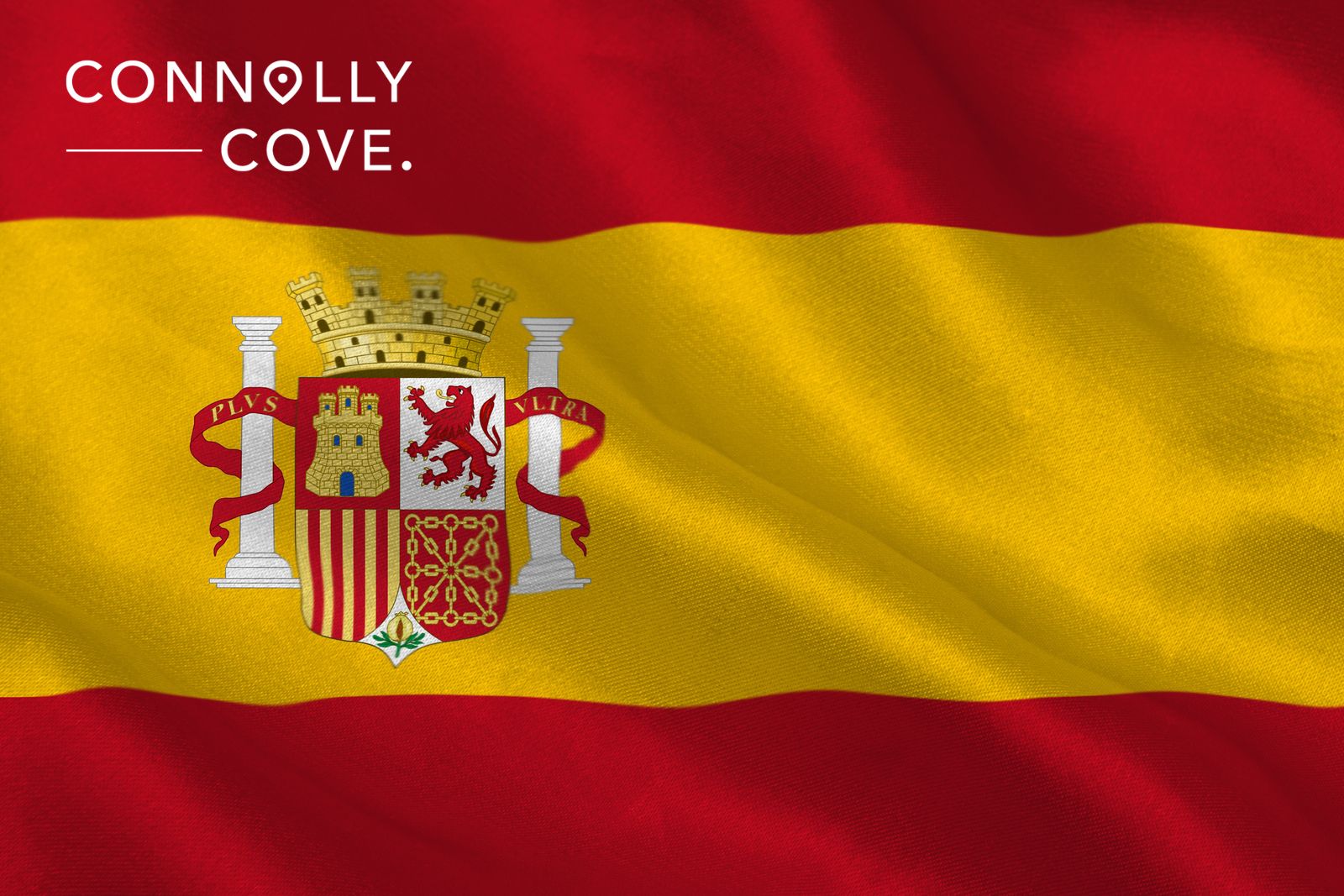
Updated On: April 16, 2024 by Esraa Mahmoud
The Spanish flag is like a vibrant tapestry of crimson and gold that flutters proudly across the Iberian Peninsula. Its colours, bold and evocative, whisper tales of conquest, resilience, and a fervent spirit that has weathered centuries of triumph and tribulation. But beneath the surface of this seemingly simple bicolour lies a wealth of symbolism; each thread is woven into its fabric as a testament to the Spanish soul.
Like the country it belongs to, the Spanish flag has such an interesting story behind it, which would definitely surprise you! The Spanish flag has not always been as we know it today; in fact, the red and yellow just celebrated its 175th anniversary in 2018.
The history of the Spanish flag, which is also known as the “rojigualda,” began during the reign of Charles III. The Spanish flag has its origins in the flag of the Navy and merchant navy of the time of Carlos III (1785), but it was during the reign of Isabel II, specifically in 1843, that it was imposed as a unitary flag.
Until then, the different regiments carried different flags and insignia. So what’s the history behind the Spanish flag, and what is the meaning of its colours? Let’s find out!
The History of the Spanish Flag
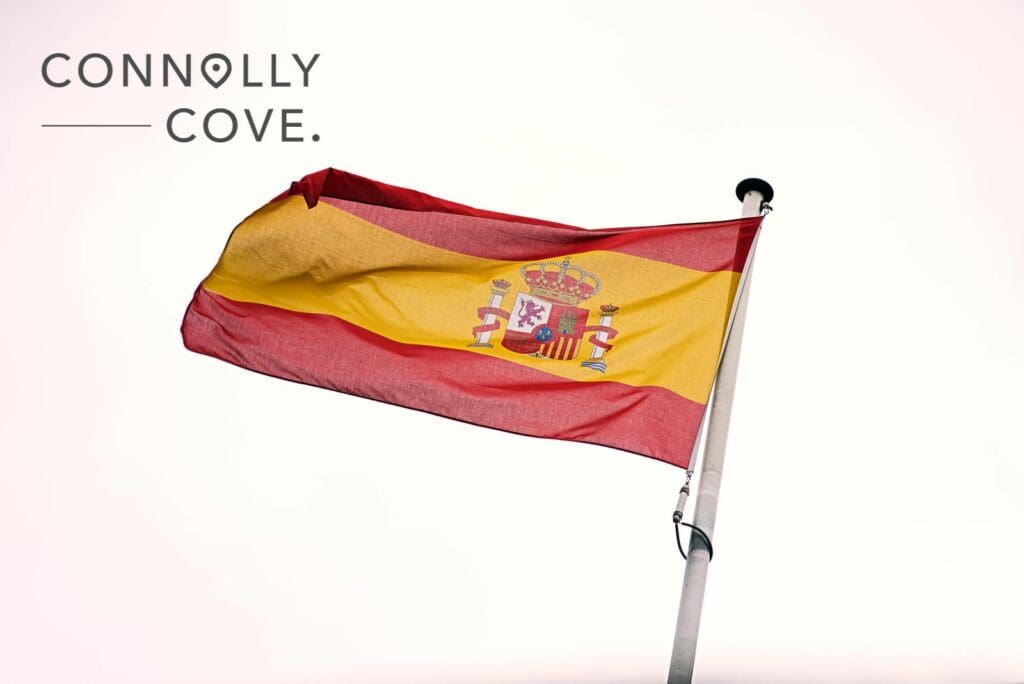
The Spanish flag’s origins trace back to the Reconquista (in English reconquest, which refers to the campaigns led by the Christian kingdoms against the Muslims after the Umayyad conquest of Hispania). It is a centuries-long struggle against Muslim rule in the Iberian Peninsula.
During the Reconquest, the Christians gradually abandoned the emblem inherited from the Romans and Visigoths and adopted flags in the style of their Muslim enemies, with the difference that they placed the same figures and colours on the stripes as on their coats of arms.
At that time, Christian kingdoms coalesced under the banner of Burgundy, a crimson field bearing a golden castle. This emblem, a symbol of strength and defiance, became the nucleus of what would eventually become the Spanish flag. As the Reconquista progressed, the castle evolved into simpler forms, eventually morphing into the iconic horizontal stripes of red and gold we see today.
It is worth mentioning that the Spanish flag has not remained static throughout history. It has undergone subtle changes, reflecting the evolving political landscape of the nation. In 1479, with the marriage of Isabella of Castile and Ferdinand of Aragon, a unified Spain emerged. However, their kingdoms initially retained their separate flags. Under the Habsburg dynasty (16th-18th centuries), a red saltire cross on a white field called the Cross of Burgundy, became prominent on Spanish flags.
By the late 18th century, the red and yellow stripes, likely inspired by regional maritime flags, started gaining popularity. Their origins are debated, but some attribute them to the House of Bourbon (founders of the French kingdom) or even earlier Catalan flags.
During the Second Spanish Republic (1931-1939), the flag briefly adopted a purple stripe, symbolizing the republican ideals of liberty and equality. However, with the rise of Franco’s dictatorship (1939-1975), the purple was discarded, and the traditional red and gold bicolour was reinstated, a symbol of national unity and unwavering patriotism.
The Meaning of the Colours
The colours of the Spanish flag today correspond to those of the design commissioned by Charles III to his Minister of the Navy, Fra’ Antonio Valdés, in 1785. The reason for these special colours was to be able to distinguish the flag easily from other flags, particularly on the high seas, as at that time, many countries used insignia with white backgrounds that were confusing in the distance.
There has been much speculation as to why Charles III chose these colours, and symbolic explanations have been sought. The red, some say, represents the blood spilt in countless battles, a stark reminder of the sacrifices made to reclaim the land. Others see it as a symbol of the fiery passion that burns within the Spanish heart, a testament to their unwavering spirit.
The golden stripes, on the other hand, shimmer with a multitude of interpretations. They evoke the riches of Spain, a land once laden with gold from the Americas, a testament to its imperial might and economic prowess. They also represent the sun, a source of life and prosperity, bathing the land in its golden glow. For other people, the gold embodies the enduring spirit of the Spanish people, their unwavering optimism and resilience in the face of adversity.
However, the Spanish flag is more than just stripes of colour. The proportions, meticulously defined, hold their own significance. The red bands, twice the width of the gold, symbolize the dominance of the people over the land, a constant reminder that the true power of Spain lies in its people.
The offset placement of the stripes, with the yellow band slightly closer to the hoist, is believed to be a nod to the maritime history of the nation, a tribute to the explorers who sailed under this banner, charting new courses and expanding the Spanish horizons.
Top Sightseeing In Spain!
Spain is one of the richest countries in the world in terms of history, culture, gastronomy, and landscapes. There is so much to see in Spain; it could take a lifetime just to visit each of its small villages, its wonderful beaches and natural parks that will leave any visitor speechless. Like its flag, Spain has plenty of interesting aspects to it and many interesting places to visit. Coming up next, we list only some of them.
Sagrada Familia
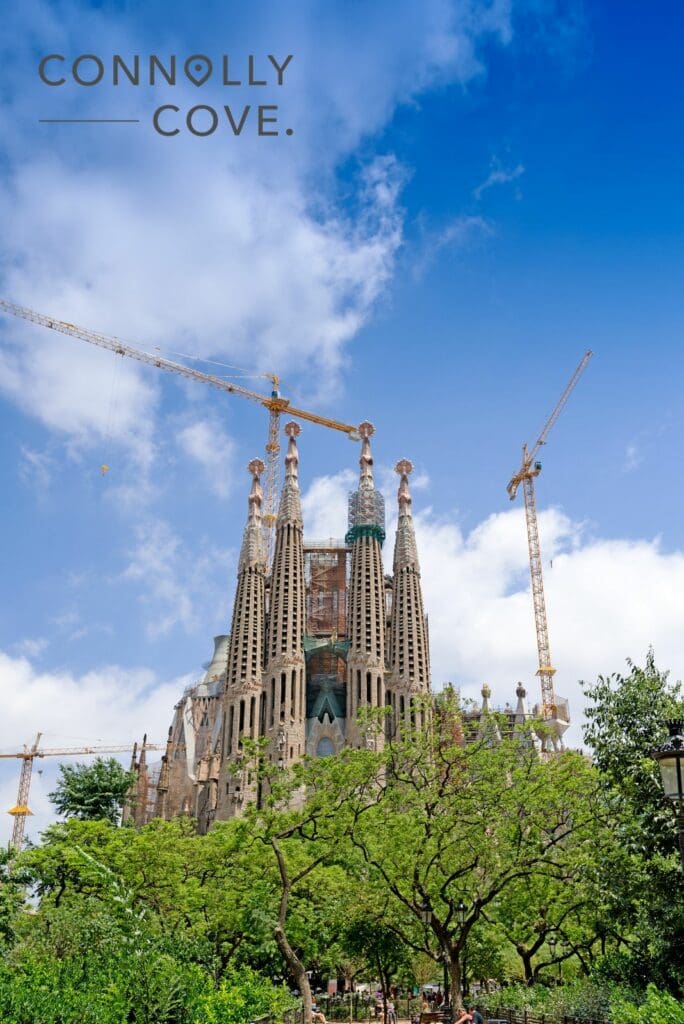
If there is one well-known monument that you have to see in Spain, it would definitely be the Sagrada Familia. Sagrada Familia is a whimsical basilica that defies categorization and inspires awe.
Rising like a fantastical forest of stone and stained glass, it’s a dream sculpted in reality; the late brilliant Antonio Gaudí’s masterpiece whispers tales of faith, nature, and architectural audacity. It wouldn’t be an exaggeration to say that Barcelona‘s skyline wouldn’t be the same without it.
Prepare yourself to embark on a journey through this enigmatic creation, where every spire speaks of celestial aspirations, every facade tells a story, and every sunbeam refracted through coloured glass paints the interior in a kaleidoscope of divine light.
Approaching the Sagrada Familia is like entering a fairytale. Its intricate facades, adorned with naturalistic sculptures and otherworldly forms, seem to breathe and pulsate with life. It is true that it is not even finished, but Sagrada Familia is still one of the best places of interest in Spain for its architectural value.
Of course, you can take advantage of the fact that you are in Barcelona, one of the must-see cities in Spain, and also take this free tour to see some of the other important monuments in the historic centre of Barcelona.
The Alhambra, Granada
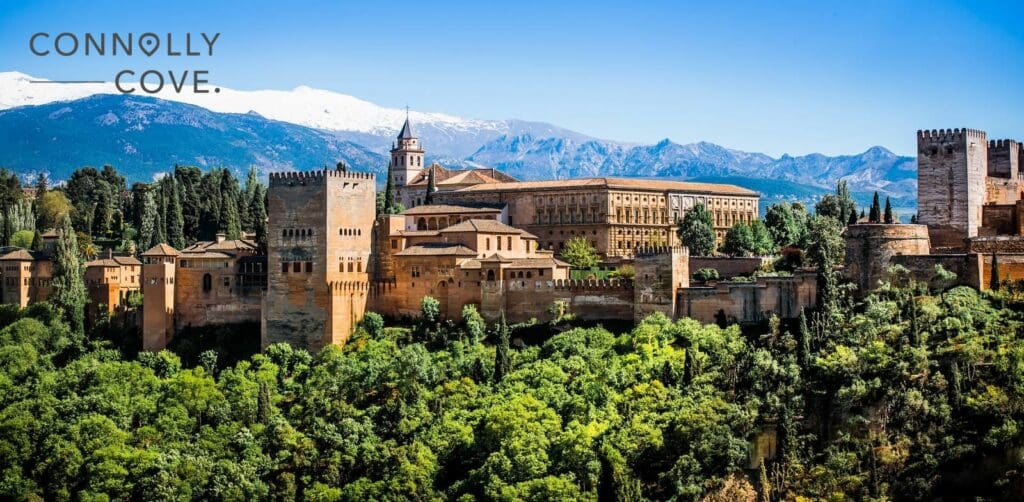
Nestled amidst the foothills of Spain’s Sierra Nevada mountains, the Alhambra Palace in the province of Granada is a jewel of Islamic architecture. In fact, this is more than just a palace; it’s a mixture woven of history, art, and nature, whispering tales of a bygone era when Moorish rulers reigned over vibrant Andalusia.
The Alhambra is a magnificent reminder of the final flourishing of Islamic art and culture in Spain. Built by the Nasrid dynasty (The Nasrid dynasty was a Muslim Berber dynasty that ruled the Emirate of Granada in southern Spain from 1232 to 1492), it holds the essence of a bygone era when Moorish rulers reigned over Andalusia.
Blending Islamic, Jewish, and Christian influences, Alhambra’s architecture showcases a breathtaking fusion of styles. Delicate stucco work, intricate geometric patterns, and harmonious courtyards create a visual feast for the senses.
Each element of the Alhambra, from the muqarnas ceilings to the serene courtyards, is meticulously crafted with extraordinary attention to detail. The harmonious blend of the patterns, flowing arches, and water features create a sense of tranquillity and wonder.
The Patio de los Leones (Courtyard of the Lions) is perhaps the most iconic symbol of the Alhambra. The graceful lions guarding the central fountain and the intricate muqarnas ceiling create a magical atmosphere.
Beyond the obvious, the Alhambra hides numerous hidden gems, like the Generalife Gardens with their terraced pools and fragrant roses, and the Alcazaba, a formidable fortress showcasing the defensive prowess of the Nasrid dynasty.
Cathedral of Burgos
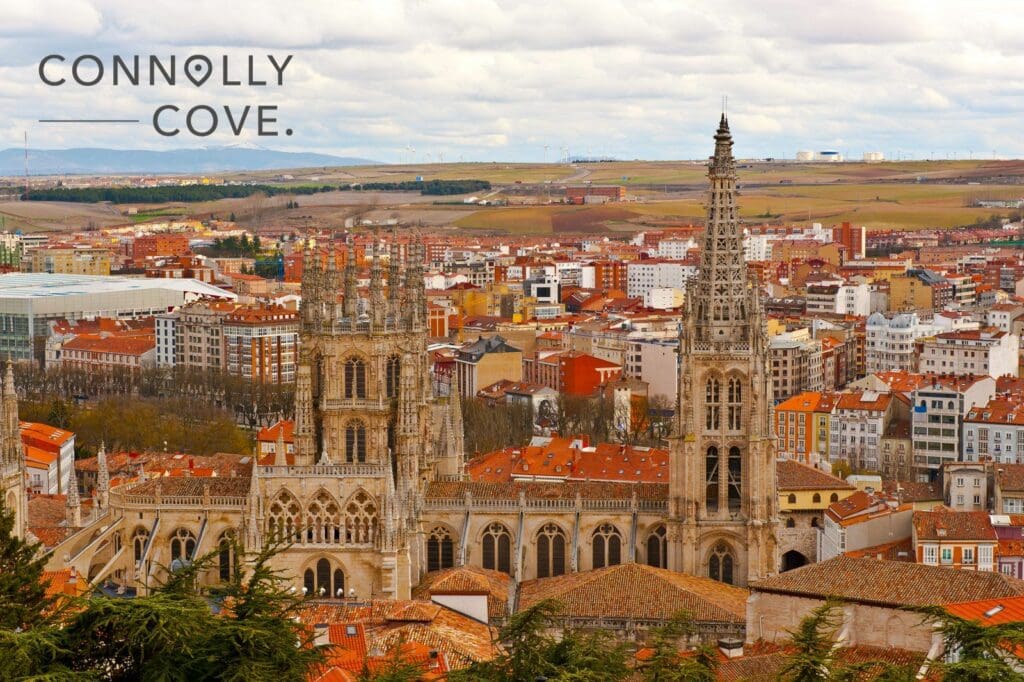
The Cathedral of Burgos is one of the most beautiful cathedrals in the country, and it is also recognised as a World Heritage Site by UNESCO.
Built between 1221 and 1567, the cathedral is a prime example of Spanish Gothic architecture, showcasing towering spires, pointed arches, ribbed vaults, and intricate stained glass windows.
The cathedral’s construction spanned centuries, allowing it to incorporate elements of evolving Gothic styles, from Early to Late Gothic and beyond. This makes it a fascinating case study for observing the architectural development of this era.
Despite its complexity, the cathedral maintains a harmonious balance between its different elements. The scale, proportions, and light distribution create a sense of awe and inspire devotion.
The cathedral boasts a wealth of sculptures, from ornate portals and choir stalls to intricate tombs and reliquaries. These artworks depict biblical scenes, historical figures, and mythical creatures, offering a glimpse into medieval artistic expression.
Another notable element of the cathedral is definitely its stained glass windows, which are masterpieces of light and colour, narrating biblical stories and bathing the interior in an ethereal glow. Also, the high altars, known as Capillas Mayores, are particularly impressive, showcasing detailed carvings, gilded elements, and breathtaking paintings.
Visit San Sebastián
Nestled on the Basque coast of Spain, San Sebastián isn’t just a city; it’s a symphony of senses, a vibrant tapestry woven with sun-kissed beaches, delectable pintxos (tapas), and a laid-back atmosphere that will leave you feeling utterly charmed. So, ditch the guidebooks and pack your appetite for adventure because here’s why San Sebastián should be at the top of your travel bucket list:
The city has so much to offer; however, the most visited place in the city is undoubtedly the Old Quarter, a labyrinth of narrow streets teeming with life. Also, you have to make a stop at the Plaza de la Constitución and the colourful buildings.
San Sebastián is the perfect base for exploring the Basque Country. Take a day trip to Bilbao, admire the Guggenheim Museum’s modern marvel, or head to the French border for a taste of Basque cider and stunning scenery.
Calas de Mallorca, Mallorca
Mallorca, the largest Balearic island, cradles a string of hidden gems along its coastline, aka the resort town Calas de Mallorca. The main attraction there is undoubtedly the string of beautiful coves with turquoise waters, soft sand, and sheltered bays. Popular ones like Cala Domingos and Cala Antena offer the perfect backdrop for swimming, sunbathing, and watersports like kayaking and paddleboarding.
Unlike some busier resorts on the island, Calas de Mallorca maintains a laid-back vibe. The pace is slower, the atmosphere welcoming, and the focus is on relaxation and enjoying the scenery.
But Calas de Mallorca is more than just sun-kissed sand and sapphire waters. Kayak through hidden grottoes, their emerald depths illuminated by shafts of sunlight, or hike along coastal trails, the scent of rosemary and thyme perfuming the air as breathtaking panoramas unfold before you.
Beyond the beaches, the surrounding rolling hills and pine forests offer opportunities for walks, bike rides, and exploring hidden coves. The nearby Punta de n’Amer nature reserve is a haven for birdwatchers and nature enthusiasts.
Also, we recommend venturing inland to charming villages like Sant Llorenç des Cardassar, where time seems to have stood still, or exploring the ancient ruins of Pollença that whisper tales of long-forgotten civilizations. The Calas offer a treasure trove of experiences beyond the beach, waiting to be unearthed.
The Prado Museum, Madrid
Nestled in the heart of Madrid, Spain, The Prado Museum is a temple of artistic glory. The museum is more than just a collection of paintings; it’s a portal to centuries of creative expression, where masterpieces by Goya, Velázquez, El Greco, and countless others whisper tales of Spanish history, cultural vibrancy, and the enduring power of human imagination.
As you cross the grand threshold, the sheer scale of the museum’s neoclassical facade leaves you breathless. Stepping inside, the vast central hall, the Salón de Reinos, welcomes you with an opulent array of statues and portraits of Spanish monarchs. It’s a fitting prelude to the artistic feast that awaits.
Prepare to embark on a journey through this artistic wonderland, where every brushstroke ignites wonder, every room unveils a new treasure, and every corner echoes with the whispers of genius.
Wine Tasting in la Rioja
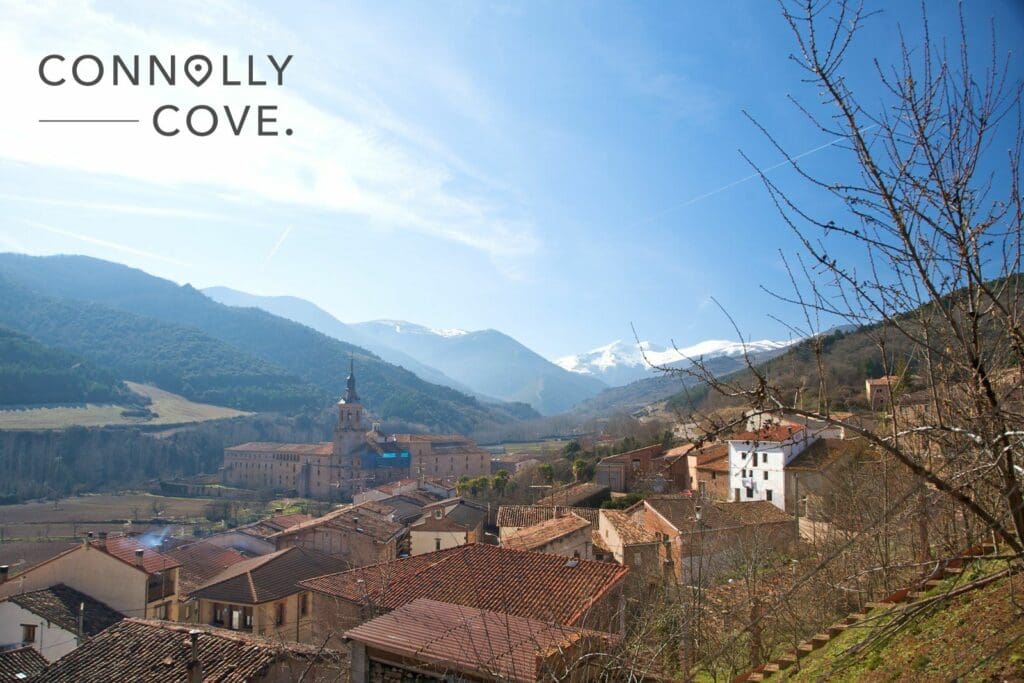
Spain is the country with the largest cultivated area of vineyards in the world and the third largest in terms of production. So, it would be a shame to make it to Spain without enjoying some wine, especially the one in La Rioja.
La Rioja is, par excellence, one of the best places in Spain to taste wine. La Rioja’s crown jewel is the Tempranillo grape, known for producing rich, complex wines with notes of red fruit, spice, and leather. The unique Rioja Alta, Rioja Baja, and Rioja Alavesa subregions each lend their own nuances to the grape, offering a spectrum of flavours to explore.
Located in the Ebro Valley, La Rioja benefits from a unique climate—hot summers tempered by cool Atlantic breezes and the protective backdrop of the Sierra de Cantabria mountains. This creates ideal conditions for grapes to ripen fully while retaining acidity, resulting in balanced and elegant wines.
Winemaking in La Rioja dates back centuries, with generations of families honing their craft and passing down knowledge. This rich tradition translates to a deep understanding of the land and grapes, reflected in the quality and craftsmanship of the wines, so make sure not to miss the wine-tasting experience while in Spain!
Salamanca
Salamanca nicknamed the “Golden City” for its sandstone buildings bathed in warm Iberian sunlight, holds a special charm that attracts countless visitors each year. It has been a UNESCO World Heritage Site since 1998 and has the oldest university in the country.
The ochre hue of the sandstone, used throughout the city’s historic buildings, creates a unique visual landscape that shifts with the changing light. Explore the Plaza Mayor, a masterpiece of Renaissance architecture, or wander through the labyrinthine streets and admire the intricate details of churches and palaces.
Salamanca pulsates with energy throughout the year, so if you make it there, make sure to catch one of the parades of the Carnaval or join the joyous celebration of the Festival de Salamanca in June, featuring concerts, theatre productions, and cultural events.
Spain beckons like a vibrant tapestry woven with the fiery red and golden yellow of its flag. Each colour paints a different picture: the sun-kissed beaches lapped by turquoise waters, the passionate rhythm of flamenco, the aroma of garlic-infused tapas, the towering peaks of the Pyrenees, and the ancient whispers of Moorish palaces.






